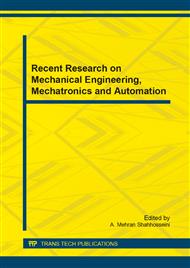p.8
p.15
p.21
p.27
p.32
p.36
p.41
p.48
p.53
Simulation Analysis of Firing Dynamics on a New Heavy Machine Gun
Abstract:
In order to study the automation dynamics of a certain type of Heavy Machine Gun, a virtual prototype model is established based on analysing the structural characteristics and movement principle. The dynamics model is created by ADAMS, including determining the boundary conditions of shooter and soil. The movement characteristic of bolt in rounds of continuous firing is analysed. Choosing the velocity of bolt as checkout targets, analysing the simulation result and test data comparatively, the feasibility of model is confirmation. So the foundation of further movement analysing, parameter matching and structural optimization about the rifle is laid.
Info:
Periodical:
Pages:
32-35
Citation:
Online since:
July 2014
Authors:
Price:
Сopyright:
© 2014 Trans Tech Publications Ltd. All Rights Reserved
Share:
Citation:


